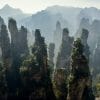The seemingly mirage-like presence of this petite desert ensconced in the mountainous Yukon Province of Canada is indeed a reality. Amid the majestic peaks, you’ll find a stretch of sand that defines a desert in miniature.
This unique sandy expanse is a product of the last glacial period, dating back 11,000 to 24,000 years, when a frozen landscape gave way to large lakes nestled among the mountains, depositing sandy deposits that have since become a cherished spot for leisure.
Typically, deserts are recognized by their sparse plant life, making them rather inhospitably to flora and fauna. The scarcity of greenery often leads to the phenomenon of denudation, in which the land is stripped bare to the forces of nature. In fact, deserts account for about one-third of our planet, often identified by their aridity and chilling temperatures, as seen in the cold desert regions of the poles.
Deserts like the Carcross Desert are shaped by a myriad of climatic factors, including the stark temperature swings from day to night that splinter rock formations. While deserts are known for their scarcity of rainfall, when rain does appear, it can result in sudden, violent floods.
Spanning a mere square mile, the Carcross Desert holds the title of the smallest desert on Earth—smaller, even, than Hoboken, New Jersey. Yet, despite appearances, Carcross is subjected to more yearly rainfall than true deserts, retaining its arid landscape due to its distinct geographical placement.
Senior meteorologist Jonathan Erdman of weather.com points to the “rain shadow” effect in the mountainous terrain of Yukon, which, alongside chilling air masses from Siberia and Alaska, hinders precipitation, aiding in keeping the region dry.
According to definitions by the United States Geological Survey, true desert climates are those which receive limited annual rainfall—a definition not met by nearby Whitehorse in Yukon, where yearly precipitation averages around 10 inches, as stated by Erdman.
Contrary to some misconceptions, the Carcross Desert’s formation is credited to its once glacially-fed lake, Watson Lake, which receded after the Ice Age, leaving behind the sands that underpin this miniature desert.
Over time, the Watson River channeled these deposits into Bennet Lake, while persistent winds sculpted the remarkable dunes that make up Carcross. Two uncommon plants—the Siberian Sedge and the Yukon Lupine—play a crucial role in safeguarding these dunes from erosion.
Today, the Carcross Desert remains a hub for outdoor enthusiasts, with activities like sandboarding, hiking, and off-roading prevalent. While conservation efforts were proposed in 1992 to protect the dunes from erosion, they were ultimately not adopted due to community opposition.
Image Source: Galyna Andrushko / Shutterstock







































